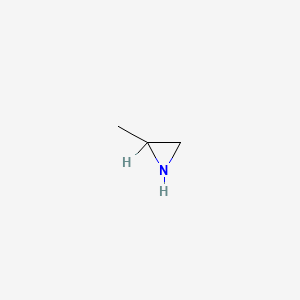
Synopsis
Synopsis
0
API Suppliers
0
USDMF
0
CEP/COS
0
JDMF
0
EU WC
0
KDMF
0
NDC API
0
VMF
0
Listed Suppliers
0
EDQM
0
USP
0
JP
0
Others
0
FDF Dossiers
0
FDA Orange Book

0
Europe

0
Canada

0
Australia

0
South Africa

0
Listed Dossiers
DRUG PRODUCT COMPOSITIONS
0
US Patents
0
US Exclusivities
0
Health Canada Patents
US Medicaid
NA
Annual Reports
NA
Regulatory FDF Prices
NA
0
API
0
FDF
0
Data Compilation #PharmaFlow
0
Stock Recap #PipelineProspector
0
Weekly News Recap #Phispers
0
News #PharmaBuzz


1. Propylene Imine
2. Propyleneimine
1. Propyleneimine
2. Propylenimine
3. Aziridine, 2-methyl-
4. 75-55-8
5. Methylaziridine
6. 1,2-propylenimine
7. 2-methylethylenimine
8. Methylethylenimine
9. 1,2-propyleneimine
10. 2-methylazacyclopropane
11. 2-methyl Aziridine
12. Rcra Waste Number P067
13. Nsc 20655
14. Propyleneimine, Inhibited
15. Ulc972q7tz
16. Chebi:82340
17. Propylene Imine
18. 2-methylaziridine (propylenimine)
19. Nsc-20655
20. Propilenimina
21. Propilenimina [spanish]
22. S-2-methylaziridine
23. Ccris 539
24. Hsdb 739
25. Dl-2-methylaziridine
26. Einecs 200-878-7
27. Un1921
28. Rcra Waste No. P067
29. Unii-ulc972q7tz
30. Brn 0102386
31. Ai3-50325
32. Dsstox_cid_4286
33. Ec 200-878-7
34. Wln: T3mtj B1
35. Dsstox_rid_77355
36. Dsstox_gsid_24286
37. Propyleneimine [hsdb]
38. 5-20-01-00150 (beilstein Handbook Reference)
39. Un 1921 (salt/mix)
40. Chembl3183775
41. Dtxsid8024286
42. Ozdgmoyksfplse-uhfffaoysa-
43. 2-methylaziridine [iarc]
44. 2-?methylaziridine (propylenimine)
45. Nsc20655
46. Tox21_202944
47. Stl168051
48. 2-methylaziridine, (+/-)-
49. Akos005366679
50. Cas-75-55-8
51. Ncgc00260490-01
52. 2-methylaziridine, Technical Grade, 90%
53. Db-016804
54. Ft-0649217
55. C19257
56. Q7250470
57. Propyleneimine, Inhibited [un1921] [flammable Liquid]
| Molecular Weight | 57.09 g/mol |
|---|---|
| Molecular Formula | C3H7N |
| XLogP3 | 0 |
| Hydrogen Bond Donor Count | 1 |
| Hydrogen Bond Acceptor Count | 1 |
| Rotatable Bond Count | 0 |
| Exact Mass | 57.057849228 g/mol |
| Monoisotopic Mass | 57.057849228 g/mol |
| Topological Polar Surface Area | 21.9 Ų |
| Heavy Atom Count | 4 |
| Formal Charge | 0 |
| Complexity | 26.5 |
| Isotope Atom Count | 0 |
| Defined Atom Stereocenter Count | 0 |
| Undefined Atom Stereocenter Count | 1 |
| Defined Bond Stereocenter Count | 0 |
| Undefined Bond Stereocenter Count | 0 |
| Covalently Bonded Unit Count | 1 |
The application of (1)H nuclear magnetic resonance (NMR) spectroscopy to the study of the biochemical effects of six nephrotoxic compounds, including mercury-chloride (HgCl2), was investigated in the male Fischer-344-rat. The rats were treated with nephrotoxic doses of sodium-chromate, cisplatin, hexachlorobutadiene, HgCl2, propylene-imine, and bromoethanamine. 1H-NMR spectroscopy and conventional biochemical methods were used to provide biochemical fingerprints of urine collected up to 48 hours after dosing. Severe glycosuria and transient enzymuria were produced by hexachlorobutadiene and HgCl2. Aminoaciduria, glycosuria, and lactic aciduria were noted after exposure to all proximal tubular toxins with the exception of cisplatin. Papillary insult resulted in early elevations in urinary trimethylamine-N-oxide and dimethylamine, together with later elevations in urinary acetate, succinate, and N,N-dimethylglycine /after propylene-imine/.
Gartland KP et al; Mol Pharmcol 35 (2): 242-250 (1989)
ABOUT THIS PAGE
92
PharmaCompass offers a list of 2-Methylaziridine API manufacturers, exporters & distributors, which can be sorted by GMP, USDMF, JDMF, KDMF, CEP (COS), WC, Price,and more, enabling you to easily find the right 2-Methylaziridine manufacturer or 2-Methylaziridine supplier for your needs.
Send us enquiries for free, and we will assist you in establishing a direct connection with your preferred 2-Methylaziridine manufacturer or 2-Methylaziridine supplier.
PharmaCompass also assists you with knowing the 2-Methylaziridine API Price utilized in the formulation of products. 2-Methylaziridine API Price is not always fixed or binding as the 2-Methylaziridine Price is obtained through a variety of data sources. The 2-Methylaziridine Price can also vary due to multiple factors, including market conditions, regulatory modifications, or negotiated pricing deals.
A 2-Methylaziridine manufacturer is defined as any person or entity involved in the manufacture, preparation, processing, compounding or propagation of 2-Methylaziridine, including repackagers and relabelers. The FDA regulates 2-Methylaziridine manufacturers to ensure that their products comply with relevant laws and regulations and are safe and effective to use. 2-Methylaziridine API Manufacturers are required to adhere to Good Manufacturing Practices (GMP) to ensure that their products are consistently manufactured to meet established quality criteria.
A 2-Methylaziridine supplier is an individual or a company that provides 2-Methylaziridine active pharmaceutical ingredient (API) or 2-Methylaziridine finished formulations upon request. The 2-Methylaziridine suppliers may include 2-Methylaziridine API manufacturers, exporters, distributors and traders.
2-Methylaziridine Active pharmaceutical ingredient (API) is produced in GMP-certified manufacturing facility.
GMP stands for Good Manufacturing Practices, which is a system used in the pharmaceutical industry to make sure that goods are regularly produced and monitored in accordance with quality standards. The FDA’s current Good Manufacturing Practices requirements are referred to as cGMP or current GMP which indicates that the company follows the most recent GMP specifications. The World Health Organization (WHO) has its own set of GMP guidelines, called the WHO GMP. Different countries can also set their own guidelines for GMP like China (Chinese GMP) or the EU (EU GMP).
PharmaCompass offers a list of 2-Methylaziridine GMP manufacturers, exporters & distributors, which can be sorted by USDMF, JDMF, KDMF, CEP (COS), WC, API price, and more, enabling you to easily find the right 2-Methylaziridine GMP manufacturer or 2-Methylaziridine GMP API supplier for your needs.
A 2-Methylaziridine CoA (Certificate of Analysis) is a formal document that attests to 2-Methylaziridine's compliance with 2-Methylaziridine specifications and serves as a tool for batch-level quality control.
2-Methylaziridine CoA mostly includes findings from lab analyses of a specific batch. For each 2-Methylaziridine CoA document that a company creates, the USFDA specifies specific requirements, such as supplier information, material identification, transportation data, evidence of conformity and signature data.
2-Methylaziridine may be tested according to a variety of international standards, such as European Pharmacopoeia (2-Methylaziridine EP), 2-Methylaziridine JP (Japanese Pharmacopeia) and the US Pharmacopoeia (2-Methylaziridine USP).
